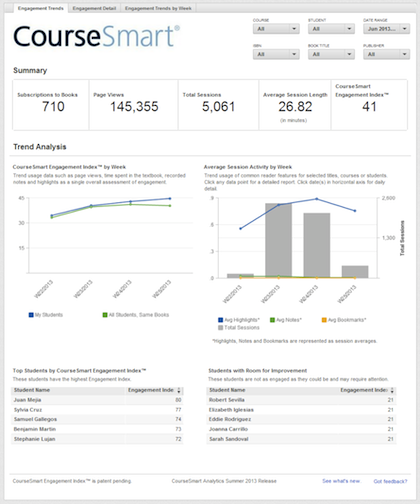CourseSmart Adds Analytics on Student E-Text Usage
- By Dian Schaffhauser
- 08/01/13
E-textbook vendor CourseSmart has released a data analytics platform that has been in testing since last year. Customers that opt into the tool will be able to access dashboards that report on digital textbook usage by students, the assumption being that knowing those metrics can help increase student learning outcomes and retention. At the same time, CourseSmart said it had revised the platform in response to feedback received from beta participants.
The beta program to test CourseSmart Analytics kicked off in fall 2012 with Texas A&M University-San Antonio and Rasmussen College. The testing expanded for the spring semester to nine institutions. According to the company, participation drew about 3,700 students, 76 faculty members, and 26 administrators across those schools.
The analytics product monitors and reports on usage data such as page views, time spent in a textbook, number of notes added, and amount of highlighting done by a student. It also offers an "engagement index," a number generated by a proprietary algorithm that communicates how engaged a student is with the e-textbook material. The reporting provided to faculty based on CourseSmart data can be shared by the instructor with individual students who will only see their own results.
| |

CourseSmart Analytics provides usage data such as page views, time spent in a textbook, number of notes added, and amount of highlighting done by a student. |
|
According to Senior VP of Marketing Cindy Clarke, the index is a "relative value" that can be used by an instructor to compare engagement for all or a filtered group of students in the class or even for users of that particular e-textbook across all of CourseSmart's customers. The index provides a score between 20 and 80, she noted, which was intentionally set so that nobody would be led to think it was somehow tied to the grading system.
"For instance, you might have a psychology student in one class that has an engagement score of 40, which might be very, very good for that class and that book," Clarke explained. "Whereas you might have a biology student in another completely different class with a completely different score which might also be good for that book and that class. It's only to be taken in the context of the class or the specific course materials that are assigned."
Adrian Guardia, who teaches human resources management courses at Texas A&M University-San Antonio, one of the pilot institutions, participated in the spring beta program with three classes. He said in a prepared statement that a benefit of the engagement index was that it served as a catalyst to initiate conversations with two of his students with a particularly low score that might not have happened otherwise. "As we discussed the students' engagement levels, [they] admitted they were having trouble or were not keeping up with assigned reading. I found significant value in using the technology to better understand how my students were learning and intervene before they fell too far behind." As a result, he added, both students pulled up their performance and passed the course.
Based on the beta experiences, CourseSmart has updated the user interface for its analytics product.
- Previously, engagement and activity charts trended monthly. Now they trend weekly;
- An Engagement Index by Week chart was added to show weekly patterns;
- "Sessions" with the e-textbook are now counted;
- The report uses color coding to identify students who are "top performing" and those who have "room for improvement."
- Users can also now select various report subheadings to reveal options to export information in PDF, XLS, and CSV file formats.
A single "administrator" version of the analytics program is free with every integration of CourseSmart e-textbooks into the campus learning management system. Usage by more than that one user is based on a tiered pricing scheme. Said Clarke, pricing is "based on volumes of book usage. But when you look at it as a per-student charge and you think about how much institutions actually spend on acquiring and retaining students, just one student retained in a class pays for a whole campus worth of CourseSmart Analytics."
About the Author
Dian Schaffhauser is a former senior contributing editor for 1105 Media's education publications THE Journal, Campus Technology and Spaces4Learning.